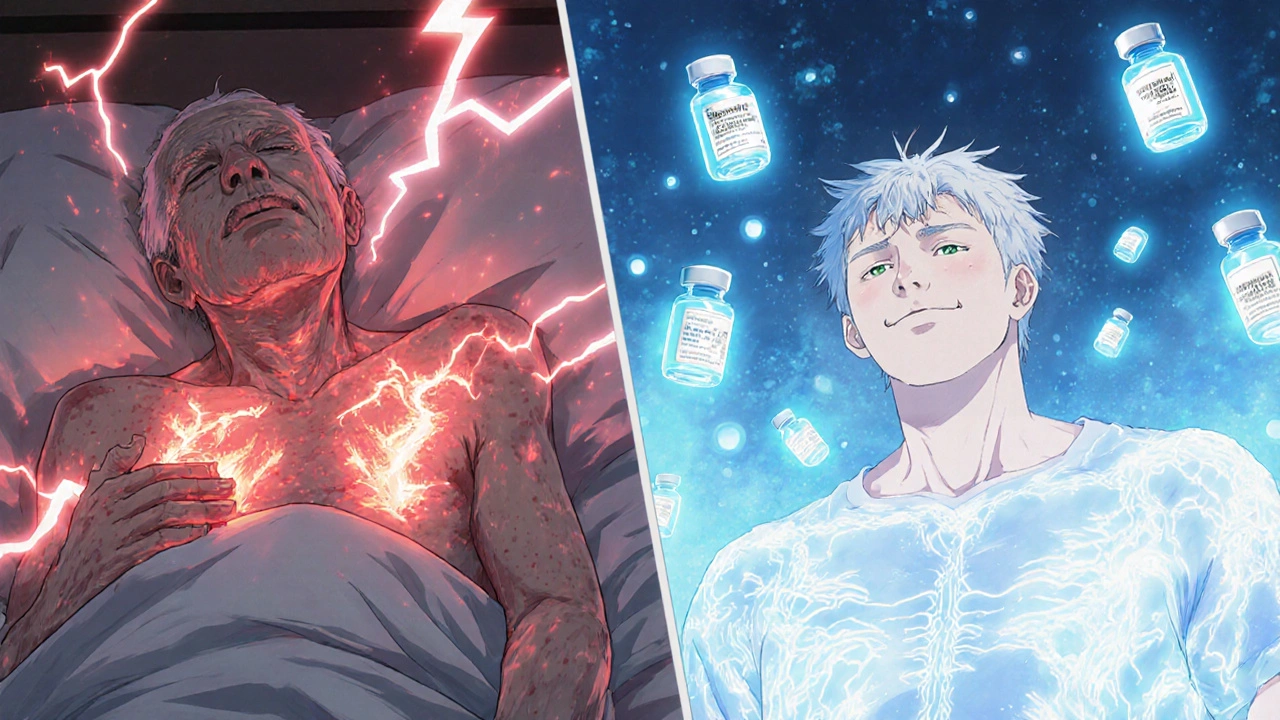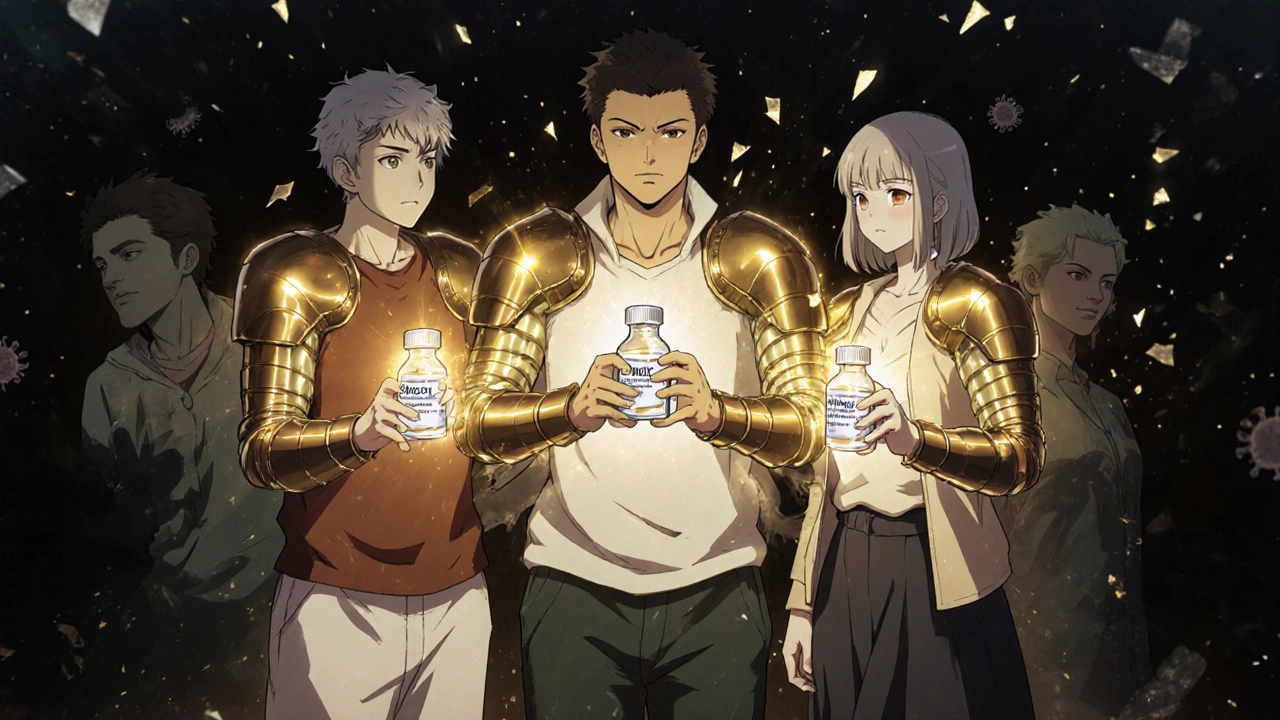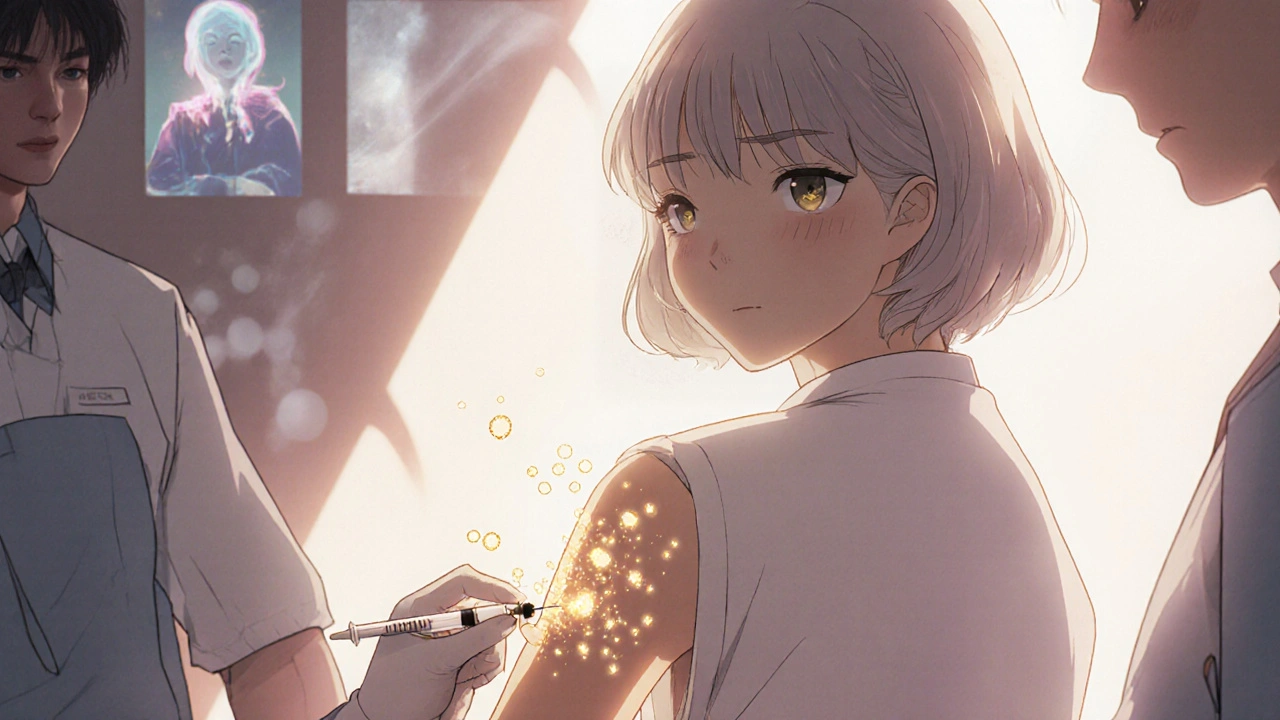Shingles isn’t just a rash. For many people, it’s months of burning pain, sleepless nights, and long-term nerve damage that won’t go away. If you’ve ever seen someone struggle with postherpetic neuralgia - pain that lingers after the blisters heal - you know why this vaccine matters. The recombinant zoster vaccine, sold as Shingrix, is now the only shingles vaccine available in the U.S. and the gold standard worldwide. But who exactly needs it? And why is it so different from what was used before?
Who Should Get the Recombinant Zoster Vaccine?
If you’re 50 or older, you should get Shingrix - no exceptions. That’s the clear, consistent recommendation from the CDC, the FDA, and every major medical association. You don’t need to have had shingles before. You don’t need to be sick or at high risk. Age alone is enough. By 85, about half of all adults will have had shingles. The older you get, the worse it gets. The vaccine cuts your risk of shingles by more than 90%, even past age 70.
But here’s the part many people miss: if you’re 19 or older and your immune system is weakened - whether from cancer treatment, HIV, organ transplant, or long-term steroid use - you also need Shingrix. You’re at much higher risk for severe shingles and complications. And unlike the old vaccine, Shingrix is safe for you because it doesn’t contain any live virus. It’s made from a single protein from the virus, plus a powerful adjuvant that boosts your immune response. That’s why it works so well even when your body isn’t at its strongest.
Why Shingrix Replaced Zostavax
The old shingles vaccine, Zostavax, was pulled off the market in November 2020. It wasn’t because it was dangerous. It was because it wasn’t good enough. Zostavax was a live vaccine, meaning it used a weakened version of the virus. That made it unsafe for people with weak immune systems. And its effectiveness? Just 51% at preventing shingles. For postherpetic neuralgia, it was only 67% effective. That’s barely better than flipping a coin.
Shingrix changed everything. In clinical trials, it was 97% effective in people aged 50 to 59. At 70 and older, it still worked at 91%. For the worst complication - nerve pain that lasts months or years - it was 91% effective in younger adults and 89% in older ones. That’s not a slight improvement. That’s a revolution. And it lasts. Data shows protection stays strong for at least seven years, and experts believe it could last 15 to 20 years.
How the Vaccine Works
Shingrix doesn’t contain the virus. Instead, it has a piece of it - a protein called glycoprotein E - that the immune system recognizes as a threat. Then it adds AS01B, a special adjuvant that turns up the immune response like a loudspeaker. This combination tricks your body into building a strong, lasting defense without ever exposing you to the real virus.
That’s why it’s safe for people with autoimmune diseases, cancer, or those on immunosuppressants. You can’t get shingles from the vaccine. You also can’t pass it to others. It’s not contagious. That’s a big deal for people living with vulnerable family members - grandparents, young children, or anyone with a compromised immune system.
What to Expect After the Shot
Shingrix is effective - but it’s not gentle. About 80% of people feel pain, redness, or swelling at the injection site. Nearly half report muscle aches. Four in ten feel tired. One in three gets a headache. One in five has a fever. One in four shivers. These aren’t rare side effects. They’re normal.
Most people feel lousy for one to three days. Some need to take a day off work. But here’s what most people don’t say: if you’ve had shingles before, you’ll gladly take two days of feeling bad to avoid another outbreak. The pain of shingles can be unbearable - like lightning strikes under your skin. The vaccine side effects? They’re just sore muscles and fatigue. You can manage them with rest and ibuprofen.
Healthcare providers often warn patients: "You might feel like you got the flu." That’s not an exaggeration. But it’s temporary. And it’s nothing compared to what shingles can do.

Dosing Schedule and Administration
You need two doses. Not one. Not three. Two. The second shot should be given 2 to 6 months after the first. If you’re immunocompromised, you can get the second dose as early as 1 to 2 months later. That’s important - you don’t want to wait too long and leave yourself unprotected.
The vaccine is given as a shot in the upper arm. It’s not a nasal spray. It’s not a pill. It’s an intramuscular injection. The needle size depends on your weight - a 5/8-inch needle for lighter adults, a 1-inch needle for heavier ones. The vaccine must be refrigerated at 2°C to 8°C. Once mixed, it must be used within six hours. That’s why pharmacies and clinics handle it carefully - it’s not something you can store at home.
Who Should Not Get It?
There are only two real reasons not to get Shingrix. First, if you’ve ever had a severe allergic reaction (anaphylaxis) to any part of the vaccine. That’s rare - less than 1 in 10,000. Second, if you’re currently sick with a moderate or severe illness, especially if you have a fever. Wait until you’re better. Otherwise, there are no restrictions.
Even if you’ve had shingles before, you still need both doses. The vaccine works better than natural immunity. If you got Zostavax years ago, you still need Shingrix. The CDC says to wait at least five years after Zostavax before getting Shingrix, but even sooner is fine if you’re at risk. You’re not double-vaccinated. You’re upgrading.
Cost and Insurance Coverage
Shingrix costs about $175 for the full two-dose course. That’s less than the old Zostavax vaccine, which was $200 for just one shot. But the real story is insurance. Medicare Part D covers it fully for eligible adults. Most private insurers do too. You shouldn’t pay anything out of pocket if you’re in the recommended group.
Some pharmacies will bill your insurance directly. Others may ask you to pay upfront and reimburse you. Always check with your provider. If you’re uninsured, some public health clinics offer it at a reduced cost. The CDC’s Vaccines for Children program doesn’t cover adults, but many state health departments have programs for low-income adults.

Why Vaccination Rates Are Still Too Low
Despite all this, only about 35% of adults over 60 have gotten both doses of Shingrix. That’s far below the Healthy People 2030 goal of 70%. Why? Three reasons: confusion, fear, and forgetfulness.
Many people think they don’t need it because they never had shingles. Others are scared of the side effects and skip the second shot. Some just forget. Doctors don’t always bring it up. Pharmacies don’t always follow up.
The fix? Systematic reminders. Standing orders in clinics. Electronic alerts in medical records. Pharmacist-led vaccination programs. You shouldn’t have to remember. Your healthcare system should remind you.
What Happens If You Skip It?
If you skip Shingrix, you’re gambling with your future. Shingles isn’t just a one-time event. It can come back. One in three people who get shingles will have it again. The second time is often worse. And if you’re over 65, your risk of postherpetic neuralgia jumps to nearly 50%.
That pain doesn’t go away. It doesn’t respond well to pills. Some people need nerve blocks. Others get antidepressants just to manage the discomfort. A few end up on opioids. It affects sleep, mood, mobility - your whole life.
Shingrix doesn’t guarantee you’ll never get shingles. But it cuts your risk by more than 90%. And if you do get it? The symptoms will be milder. The pain will be shorter. The chance of long-term damage? Almost gone.
Do I need Shingrix if I already had shingles?
Yes. Even if you’ve had shingles, you should still get both doses of Shingrix. Natural immunity after shingles doesn’t provide strong or lasting protection. The vaccine reduces your risk of getting it again by more than 90%. The CDC recommends waiting at least one year after your outbreak before getting vaccinated, but you can get it sooner if your doctor agrees.
Can I get Shingrix if I’m on immunosuppressants?
Yes - and you should. Shingrix is safe for people with weakened immune systems due to cancer, HIV, organ transplants, or long-term steroid use. Unlike the old Zostavax vaccine, Shingrix contains no live virus, so it won’t cause infection. The CDC recommends two doses for anyone 19 or older who is immunocompromised, even if they’ve never had shingles.
What if I only got one dose?
One dose gives you some protection - but not enough. Studies show two doses are needed to reach over 90% effectiveness. If you missed your second shot, get it as soon as you can, even if it’s been more than six months. You don’t need to restart the series. Just complete the second dose. Delaying it doesn’t reduce the vaccine’s final effectiveness.
Is Shingrix covered by Medicare?
Yes. Medicare Part D covers the full cost of Shingrix for eligible adults aged 50 and older. You should pay nothing out of pocket if you’re enrolled. Some pharmacies may ask you to pay upfront and then refund you - ask them to bill your Part D plan directly. If you’re unsure, call your plan’s customer service before getting vaccinated.
Can I get Shingrix at the same time as my flu shot or COVID booster?
Yes. Shingrix can be given at the same visit as other vaccines, including flu, pneumonia, and COVID-19 shots. They’re administered in different arms. There’s no evidence that combining them reduces effectiveness or increases side effects. In fact, getting them together saves time and increases the chance you’ll complete your vaccination schedule.
What’s Next?
If you’re 50 or older, call your doctor or pharmacy today. Ask if you’ve received both doses of Shingrix. If not, schedule them. Don’t wait for symptoms. Don’t wait for a doctor to bring it up. This is one of the most effective vaccines you’ll ever get - and it’s free for most people.
If you’re under 50 but have a weakened immune system, talk to your provider. You might qualify. The window for protection is wide open. Don’t let confusion or fear stop you. Shingles doesn’t care if you’re young or old. It only cares if you’re unprotected.


8 Comments
November 18, 2025 Patrick Merk
Just got my second Shingrix shot last week. Felt like I got hit by a bus for two days - muscle aches, fever, the whole shebang. But honestly? Worth every second. My dad had shingles at 72 and still wakes up screaming from nerve pain. I’m not letting that happen to me. 🤝
November 19, 2025 Liam Dunne
For real - if you’re 50+ and haven’t gotten this, you’re playing Russian roulette with your nerves. I’m a nurse and I’ve seen the aftermath. That burning pain? It doesn’t just go away. Shingrix isn’t just a shot - it’s insurance against a living nightmare. And yeah, it hurts more than a flu shot. So what? You don’t get to pick which part of your body gets tortured by a virus.
November 20, 2025 Jennifer Howard
While I appreciate the sentiment, I must point out that the CDC’s recommendation is not universally supported by peer-reviewed longitudinal data. The adjuvant AS01B has been linked to transient autoimmune phenomena in a small subset of patients in European cohort studies (see: European Journal of Clinical Immunology, 2021). Furthermore, the claim that protection lasts 15-20 years is extrapolated from modeling, not empirical evidence. I find it troubling that this is being promoted as a panacea without adequate transparency regarding potential immunological trade-offs.
November 22, 2025 Abdul Mubeen
Interesting how they never mention that the ‘97% efficacy’ figure comes from trials funded by GSK. Also, why is this vaccine so expensive if it’s just a protein and an adjuvant? And why are we pushing it on healthy people when the real issue is that our immune systems are weakened by processed foods, glyphosate, and 5G? I’m not saying I won’t get it - I’m saying I’m not being manipulated into it.
November 23, 2025 mike tallent
Just got mine last month! 💪 Second shot felt like a workout, but I’m glad I did it. My grandma had shingles and it ruined her last 2 years. I’m 54, no history, but I’m not gambling. Also - you CAN get it with your flu shot! Just tell them to use different arms. Pharmacist was super helpful. 🙌 Don’t overthink it. Your future self will thank you.
November 25, 2025 Joyce Genon
Let’s be real - this whole thing is fear-mongering dressed up as public health. Half the people who get shingles are over 80 and have no quality of life to begin with. Why are we spending billions on a vaccine for a condition that mostly affects people who are already dying? And let’s not pretend the side effects are ‘manageable’ - if you’re 65 and you get a fever, muscle pain, and fatigue after the shot, you’re not just ‘taking a day off work,’ you’re potentially triggering a cascade of inflammation that could land you in the ER. And don’t get me started on the adjuvant. AS01B is basically a chemical sledgehammer to your immune system. We’re vaccinating healthy people against a disease that kills less than 100 Americans a year. That’s not prevention - that’s medical overreach. The real epidemic here is unnecessary medicalization.
November 26, 2025 John Wayne
Interesting. The data is cherry-picked. The real efficacy in real-world populations, especially among the elderly, is far lower than the clinical trial numbers suggest. And the cost-benefit analysis ignores the opportunity cost - resources diverted from actual public health crises. I’m not opposed to vaccines. I’m opposed to uncritical acceptance of industry-promoted protocols.
November 26, 2025 Julie Roe
Hey - if you’re reading this and you’re thinking, ‘I’m too young,’ or ‘I don’t need it,’ or ‘I’m scared of the side effects’ - I get it. I was there. But I also know what it looks like when someone you love can’t sleep because their skin feels like it’s on fire. I’m a nurse, and I’ve held the hands of people who cried because the pain didn’t stop for 18 months. This vaccine isn’t about fear. It’s about dignity. It’s about choosing comfort over agony. You don’t have to be brave - you just have to be smart. And if you’re over 50? You’re not too young. You’re exactly the right age. Schedule it. Bring a friend. Get it done. Your body will thank you - and so will the people who love you.
Write a comment